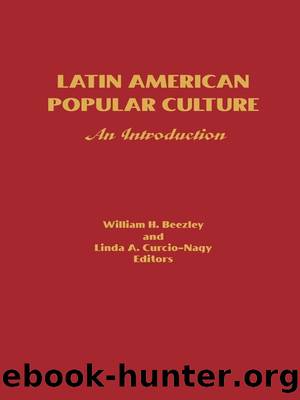Latin American Popular Culture by Unknown

Author:Unknown
Language: eng
Format: epub
ISBN: 9781461638650
Publisher: Rowman & Littlefield Publishers
Published: 2013-07-11T00:00:00+00:00
Conclusion
Adopting a historical perspective, this discussion has focused attention on the self as the main speaker in the dialogue between dominated Indian-ness and dominant nation-state. As the dominant image maker at the turn of the nineteenth century, the coastal bourgeoisie used the Indians as semiotic pawns for its own interests and to legitimize its own economic achievements.46 In the process, it also started to construct a new image of Ecuador as a corporate self. In this dominant representation, the image of mestizaje emerged as a master fiction constructed in a historical dialectical process of exclusion and inclusion of the Other.47 As pseudo-Europeans, the criollos pretended to hide the dialogue of domination by turning it into a monologue of the self who had finally assimilated the Other, or was in the process of doing so. It is possible to say, borrowing a concept from Mason, that this was the quintessential egocentric strategy of structuring alterity.48 In the process the real Indian was obliterated from consciousness, to be selectively assimilated as the historical and, if possible, the archaeological exotic Other. This strategy also created the illusion that the indigenous Other, as forged by the dominator, could be brought into the imagined community through the doorway of invented natural ties.
Times have changed and the Ecuadorian indigenous peoples are increasingly becoming their own image makers in the national and international arena. The new criollos are fighting back by reinventing their own and the nationâs cultural and ethnic identity. In addition to the president of the republic making mestizaje fashionable again, the Ecuadorian pavilion at Seville Expo 1992 adopted the diplomatic and for a long time chic attitude among the upper middle classes: the estheticization of the Indian, the Indian that can be owned in archaeological private collections or displayed in institutional museums. The pavilion showed, âwith dramatic illumination,â the giants of the bahÃa pre-Columbian culture from the coast, which were described as âshamanistic idols from 2000 years ago.â The âexotics in costumeâ whom all the visitors wanted to photograph were only mannequins of the famous Corpus Christi dancers from the highlands.49 As Foster has argued, the myth of the Other as the exotic is perpetuated by its appropriation as an objet dâart, a commodity, a focus of wonder and contemplation.50 This postmodern appropriation of the archaeological Indian as an objet dâart is significantly different from the âarchaeological patriotismâ characteristic of the criollo elite at the close of the nineteenth century. Today, real Indians, unlike the mythical ones, have assumed their political roles as historical agents, claiming for themselves the reevaluation or invention of their past to redefine their present, questioning the historical and iconographic monopoly of the criollos that archaeological patriotism assumed as given.
The folkloric Indian at the Seville exposition was turned into a tourist attraction and an ambassador of an allegedly unified nation that in fact is being forced to redefine the imagined community by its contemporary, and real, indigenous citizens. One of them, a courageous young woman from Otavalo and a museum
Download
This site does not store any files on its server. We only index and link to content provided by other sites. Please contact the content providers to delete copyright contents if any and email us, we'll remove relevant links or contents immediately.
Cecilia; Or, Memoirs of an Heiress — Volume 1 by Fanny Burney(31447)
Cecilia; Or, Memoirs of an Heiress — Volume 3 by Fanny Burney(31037)
Cecilia; Or, Memoirs of an Heiress — Volume 2 by Fanny Burney(30985)
The Great Music City by Andrea Baker(23014)
We're Going to Need More Wine by Gabrielle Union(18126)
Bombshells: Glamour Girls of a Lifetime by Sullivan Steve(13158)
Pimp by Iceberg Slim(13000)
All the Missing Girls by Megan Miranda(12838)
Fifty Shades Freed by E L James(12492)
Talking to Strangers by Malcolm Gladwell(11991)
Norse Mythology by Gaiman Neil(11963)
Crazy Rich Asians by Kevin Kwan(8412)
Mindhunter: Inside the FBI's Elite Serial Crime Unit by John E. Douglas & Mark Olshaker(7898)
The Lost Art of Listening by Michael P. Nichols(6534)
Enlightenment Now: The Case for Reason, Science, Humanism, and Progress by Steven Pinker(6449)
Bad Blood by John Carreyrou(5816)
The Four Agreements by Don Miguel Ruiz(5577)
Weapons of Math Destruction by Cathy O'Neil(5096)
We Need to Talk by Celeste Headlee(4921)
